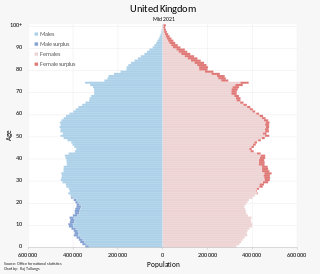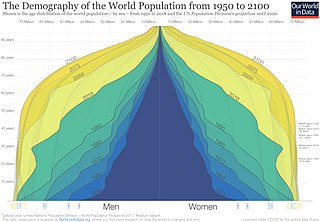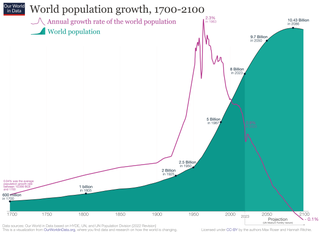Related Research Articles

The demographics of North Korea are determined through national censuses and international estimates. The Central Bureau of Statistics of North Korea conducted the most recent census in 2008, where the population reached 24 million inhabitants. The population density is 199.54 inhabitants per square kilometre, and the 2014 estimated life expectancy is 69.81 years. In 1980, the population rose at a near consistent, but low, rate. Since 2000, North Korea's birth rate has exceeded its death rate; the natural growth is positive. In terms of age structure, the population is dominated by the 15–64-year-old segment (68.09%). The median age of the population is 32.9 years, and the gender ratio is 0.95 males to 1.00 female. Since the early 1990s, the birth rate has been fairly stable, with an average of 2 children per woman, down from an average of 3 in the early 1980s.

China is the second most populous country in Asia as well as the second most populous country in the world, with a population of 1.409 billion.

Demographic features of the population of South Korea include population density, ethnicity, education level, health of the populace, economic status, religious affiliations, and other aspects of the population. The common language and especially race are viewed as important elements by South Koreans in terms of identity, more than citizenship.

The population of the United Kingdom was estimated at over 67.0 million in 2020. It is the 21st most populated country in the world and has a population density of 270 people per square kilometre, with England having significantly greater density than Wales, Scotland, and Northern Ireland. Almost a third of the population lives in south east England, which is predominantly urban and suburban, with about 9 million in the capital city, London, whose population density is just over 5,200 per square kilometre.

Demography is the statistical study of human populations: their size, composition, and how they change through the interplay of fertility (births), mortality (deaths), and migration.
In demography, demographic transition is a phenomenon and theory which refers to the historical shift from high birth rates and high death rates in societies with minimal technology, education and economic development, to low birth rates and low death rates in societies with advanced technology, education and economic development, as well as the stages between these two scenarios. In economic growth, the demographic transition has swept the world over the past two centuries, and the unprecedented population growth of the post-Malthusian period was reversed, reducing birth rates and population growth significantly in all regions of the world, and enabling economies to translate more of the gains of factor accumulation and technological progress into per capita income growth. The demographic transition strengthens economic growth process by three changes: (i) reduced dilution of capital and land stock, (ii) increased investment in human capital, and (iii) increased size of the labor force relative to the total population and changed age population distribution. Although this shift has occurred in many industrialized countries, the theory and model are frequently imprecise when applied to individual countries due to specific social, political and economic factors affecting particular populations.

The Total Fertility Rate (TFR) of a population is the average number of children that are born to a woman over her lifetime if:
- they were to experience the exact current age-specific fertility rates (ASFRs) through their lifetime
- and they were to live from birth until the end of their reproductive life.

Sub-replacement fertility is a total fertility rate (TFR) that leads to each new generation being less populous than the older, previous one in a given area. The United Nations Population Division defines sub-replacement fertility as any rate below approximately 2.1 children born per woman of childbearing age, but the threshold can be as high as 3.4 in some developing countries because of higher mortality rates. Taken globally, the total fertility rate at replacement was 2.33 children per woman in 2003. This can be "translated" as 2 children per woman to replace the parents, plus a "third of a child" to make up for the higher probability of males born and mortality prior to the end of a person's fertile life. In 2020, the average global fertility rate was around 2.4 children born per woman.
Population decline, also known as depopulation, is a reduction in a human population size. Throughout history, Earth's total human population has continued to grow; however, current projections suggest that this long-term trend of steady population growth may be coming to an end.

A population pyramid or "age-sex pyramid" is a graphical illustration of the distribution of a population by age groups and sex; it typically takes the shape of a pyramid when the population is growing. Males are usually shown on the left and females on the right, and they may be measured in absolute numbers or as a percentage of the total population. The pyramid can be used to visualize the age of a particular population. It is also used in ecology to determine the overall age distribution of a population; an indication of the reproductive capabilities and likelihood of the continuation of a species. Number of people per unit area of land is called population density.
Population momentum is a consequence of the demographic transition. Population momentum explains why a population will continue to grow even if the fertility rate declines. Population momentum occurs because it is not only the number of children per woman that determine population growth, but also the number of women in reproductive age. Eventually, when the fertility rate reaches the replacement rate and the population size of women in the reproductive age bracket stabilizes, the population achieves equilibrium and population momentum comes to an end. Population momentum is defined as the ratio of the size of the population at that new equilibrium level to the size of the initial population. Population momentum usually occurs in populations that are growing.

According to the Encyclopedia of International Development, the term demographic trap is used by demographers "to describe the combination of high fertility and declining mortality in developing countries, resulting in a period of high population growth rate (PGR)." High fertility combined with declining mortality happens when a developing country moves through the demographic transition of becoming developed.
Kingsley Davis was an internationally recognized American sociologist and demographer. He was identified by the American Philosophical Society as one of the most outstanding social scientists of the twentieth century, and was a Hoover Institution senior research fellow.

In Demography, the rate of natural increase (RNI), also known as natural population change, is defined as the birth rate minus the death rate of a particular population, over a particular time period. It is typically expressed either as a number per 1,000 individuals in the population or as a percentage. RNI can be either positive or negative. It contrasts to total population change by ignoring net migration.

Demographic history is the reconstructed record of human population in the past. Given the lack of population records prior to the 1950s, there are many gaps in our record of demographic history. Historical demographers must make do with estimates, models and extrapolations. For the demographic methodology, see historical demography.
Population change is simply the change in the number of people in a specified area during a specific time period. Demographics is the study of population statistics, their variation and its causes. These statistics include birth rates, death rates, migration rates and sex ratios. All of these statistics are investigated by censuses and surveys conducted over a period of time. Some demographic information can also be obtained from historical maps, and aerial photographs.

The ageing of Europe, also known as the greying of Europe, is a demographic phenomenon in Europe characterised by a decrease in fertility, a decrease in mortality rate, and a higher life expectancy among European populations. Low birth rates and higher life expectancy contribute to the transformation of Europe's population pyramid shape. The most significant change is the transition towards a much older population structure, resulting in a decrease in the proportion of the working age while the number of the retired population increases. The total number of the older population is projected to increase greatly within the coming decades, with rising proportions of the post-war baby-boom generations reaching retirement. This will cause a high burden on the working age population as they provide for the increasing number of the older population.

Population planning in Singapore has reflected various policies to both slow and boost the growth rate of Singapore's population. Singapore first began population planning initiatives in an attempt to slow and reverse the rapid increase in births that began after World War II. Later on, from the 1980s, policy was tailored towards growth, attempting to encourage mothers to have more children. In 2020, the annual total population growth rate in Singapore was -0.3%, and its resident total fertility rate (TFR) was 1.10, below the replacement rate of 2.1.

Population projections are attempts to show how the human population statistics might change in the future. These projections are an important input to forecasts of the population's impact on this planet and humanity's future well-being. Models of population growth take trends in human development and apply projections into the future. These models use trend-based-assumptions about how populations will respond to economic, social and technological forces to understand how they will affect fertility and mortality, and thus population growth.
Generation Alpha is a social cohort born between the early 2010s and mid 2020s. The birth years of Generation Alpha have seen a decline in birth rates, especially in the developed world.
References
- 1 2 Haupt, Arthur; Kane, Thomas T.; Haub, Carl (2011). "PRB's Population Handbook" (PDF). Population Reference Bureau. pp. 29–30.
- 1 2 Davis, Kingsley (1967). "Population policy: Will current programs succeed?". Science. 158 (3802): 730–739. Bibcode:1967Sci...158..730D. doi:10.1126/science.158.3802.730. PMID 6069101.
- ↑ "Kingsley Davis, Hoover fellow, demographer, sociologist, dies at age 88 (3/97)". www.stanford.edu. Archived from the original on 5 August 2012. Retrieved 16 September 2017.
- ↑ Stolnitz, George J. (1955). "A Century of International Mortality Trends_ I". Population Studies. 9 (1): 24–55. doi:10.2307/2172340. JSTOR 2172340.
- ↑ Mirrlees, J. A. (1967). "Optimum Growth When Technology is Changing". The Review of Economic Studies. 34 (1): 95–124. doi:10.2307/2296573. JSTOR 2296573.
- ↑ “ZPG – A New Movement Challenges the U.S. to Stop Growing”, LIFE magazine, April 27, 1970, page 12ff
- ↑ "Whatever happened to Zero Population Growth (ZPG)?". Archived from the original on 16 September 2017. Retrieved 16 September 2017.
- 1 2 3 Skirbekk, Vegard (2022). "Decline and Prosper!". SpringerLink. doi:10.1007/978-3-030-91611-4.
- ↑ "The Population Explosion". www.ditext.com. Retrieved 16 September 2017.
- ↑ Bartlett, Albert A. & Lytwak, Edward P. “Zero Growth of the Population of the United States.” (http://www.albartlett.org/articles/ee_zero_growth_population_us_1995.pdf), Population and Environment, Vol.16, Issue 5, May. 1995, pp 415-428
- ↑ Wooldridge, Frosty (April 1, 2011). "Zero Population Growth - The Only Way Out". rense.com.
- ↑ Espenshade, Thomas J.; Guzman, Juan Carlos and Westoff, Charles F. "The Surprising Global Variation in Replacement Fertility", Population Research and Policy Review, Vol.22, No. 5-6, Dec. 2003, pp. 575-583.
- ↑ "World Population Prospects 2019, Population Data, File: Total Population Both Sexes". United Nations Population Division. 2019.
- ↑ "For the first time since the 1960s, China's population is shrinking". The Economist. ISSN 0013-0613 . Retrieved 2024-01-21.
- ↑ Myers, Joe (July 25, 2016). "China's working-age population will fall 23% by 2050". World Economic Forum.
- ↑ "China reforms: One-child policy to be relaxed". BBC News. 15 November 2013. Retrieved 2014-08-25.
- ↑ Pearce, Fred (2021-12-17). "India defuses its population bomb". Science. 374 (6574): 1422–1423. doi:10.1126/science.acz9835. ISSN 0036-8075.